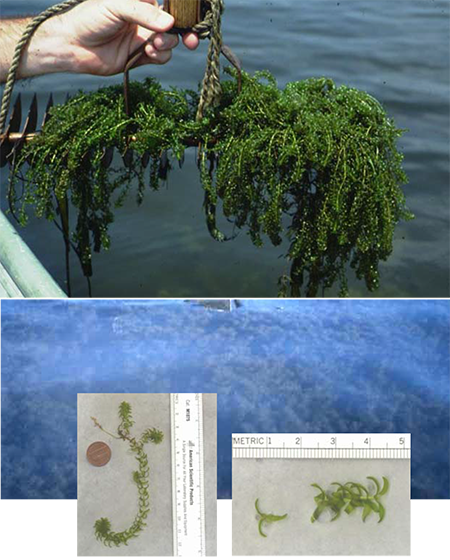Submerged Aquatic Vegetation (SAV) Identification Key
Main_Content
The bay grass key was designed to allow you to identify most species of bay grasses found in Maryland. Although bay grasses are notoriously difficult to identify using standard taxonomic keys, the flexible format of the Internet allows us to combine detailed pictures, simple line drawings and text messages in a stepwise sequence that makes identifying bay grasses simple. You may find it useful to have a clear metric ruler with millimeters marked, a magnifying glass, and a Ziploc plastic bag to help you in the process of identifying your plant.

|
If you already know the identity of a particular bay grass use the drop down boxes below. |
|---|
Common Name:
or
Scientific Name:
| | Common Name: | Common Waterweed |
| | Scientific Name: | Elodea canadensis |
| | Native or Non-native: | Native
|
| | Illustration: | 
|
| | Link to larger illustration: |
|
| | Printable Version: | |
| | Family: | Hydrocharitaceae |
| | Distribution: | Common waterweed is primarily a freshwater species, and occasionally grows in brackish upper reaches in many of the Bay's tributaries. It prefers loamy (sandy and silty) soil, slow-moving water with high nitrogen and phosphorous concentrations. |
| | Recognition: | The leaves of common waterweed can vary greatly in width, size and bunching. In general, the leaves are linear to oval with minutely toothed margins and blunt tips. Leaves have no leaf stalks, and occur in whorles of 3 at stem nodes, becoming more crowded toward the stem tips. Common waterweed has slender, branching stems and a weak, thread-like root system. |
| | Ecological Significance: | Common waterweed prefers silty sediments and nutrient rich water, where it is sometimes perceived as a nuisance. However, it will grow in a wide range of conditions, from very shallow to deep water, and in many sediment types. It can even continue to grow unrooted, as floating fragments. It is found throughout temperate North America.
Common waterweed is an important part of tidal and nontidal freshwater ecosystems. It provides good habitat for many aquatic invertebrates and cover for young fish and amphibians. Waterfowl, especially ducks, as well as beaver and muskrat eat this plant. Also, it is of economic importance as an attractive and easy to keep aquarium plant, but cannot just be taken out of a stream or lake and into an aquarium.
|
| | Similar Species: | Common waterweed resembles hydrilla (Hydrilla verticillata). Hydrilla, however, has prominent teeth on leaf margins with leaves occurring in whorls of 3-5. Underwater common waterweed resembles the water starworts (Callitriche spp.); however its leaves are in whorls of 3 whereas those of water starwort are in pairs on stem nodes. The very similar Western waterweed (Elodea nuttallii) is reported to occur in the Chesapeake Bay (Brown and Brown, 1984) but its identification (and thus its distribution) are poorly known. Elodea nuttallii may have a higher salinity tolerance (up to 10 ppt) than common waterweed. Brazilian waterweed (Egeria densa) has also been reported in the Bay, but its distribution is poorly known. |
| | Reproduction: |
Common waterweed reproduces sexually and asexually. Common waterweed is dioecious and, with the female form being more abundant than the male, sexual reproduction is rare. Sexual reproduction produces cylindrical fruit capsules. Asexual reproduction is common and occurs by stem branching, growth buds of stem fragments, and by spring development of over-wintering structures laterally. |
|
|
Center_Content
For permission to reproduce individual photos, please contact Mike Naylor
The text and photos used in this key were produced through a collaborative effort among the following partners.

